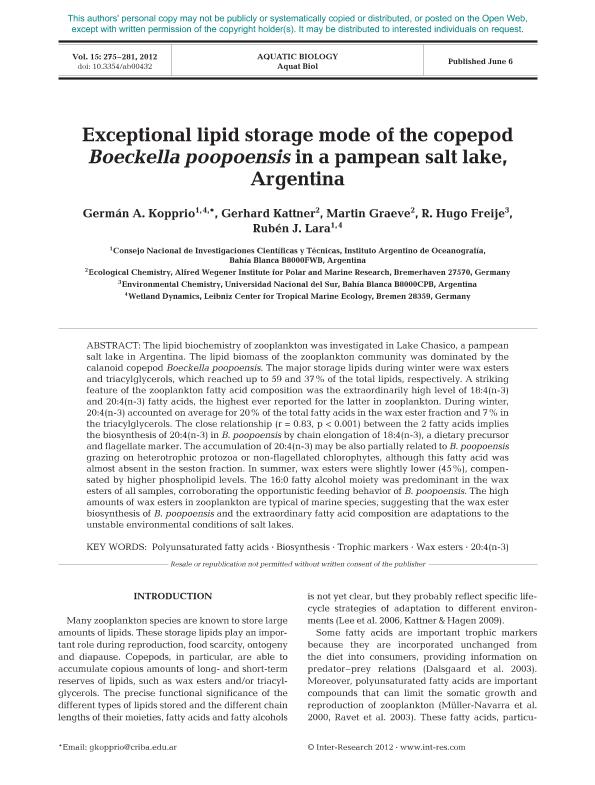Artículo
Exceptional lipid storage mode of the copepod Boeckella poopoensis in a pampean salt lake of Argentina
Fecha de publicación:
06/2012
Editorial:
Inter-Research
Revista:
Aquatic Biology
ISSN:
1864-7790
Idioma:
Inglés
Tipo de recurso:
Artículo publicado
Clasificación temática:
Resumen
The lipid biochemistry of zooplankton was investigated in Lake Chasicó, a pampean salt lake of Argentina. The lipid biomass of the zooplankton community was dominated by the calanoid copepod Boeckella poopoensis. The major storage lipids during winter were wax esters and triacylglycerols, which reached up to 59% and 37% of total lipids, respectively. A striking feature of the zooplankton fatty acid composition was the extraordinarily high level of the 18:4(n-3) and 20:4(n-3) fatty acids, the highest ever reported for the latter in zooplankton. During winter, 20:4(n-3) constituted on average 20% of total fatty acids in the wax ester fraction and 7% in the triacylglycerols. The close relationship (r = 0.83, p<0.001) between the two fatty acids implies the biosynthesis of 20:4(n-3) in B. poopoensis by chain elongation of 18:4(n-3), a dietary precursor and flagellate marker. The accumulation of 20:4(n-3) may be also partially related to B. poopoensis grazing on heterotrophic protozoa or non-flagellated chlorophytes although this fatty acid was almost lacking in the seston fraction. In summer wax esters were slightly lower (45%) compensated by higher phospholipid levels. The 16:0 fatty alcohol moiety was predominant in the wax esters of all samples, supporting the opportunistic feeding behavior of B. poopoensis. The high amounts of wax esters in zooplankton are typical of marine species, suggesting that wax ester biosynthesis of B. poopoensis, together with the extraordinary fatty acid composition, are adaptations to the unstable environmental conditions of salt lakes.
Archivos asociados
Licencia
Identificadores
Colecciones
Articulos(IADO)
Articulos de INST.ARG.DE OCEANOGRAFIA (I)
Articulos de INST.ARG.DE OCEANOGRAFIA (I)
Citación
Kopprio, Germán Adolfo; Kattner, Gerhard; Graeve, Martin; Freije, Rubén Hugo; Lara, Ruben Jose; Exceptional lipid storage mode of the copepod Boeckella poopoensis in a pampean salt lake of Argentina; Inter-Research; Aquatic Biology; 15; 3; 6-2012; 275-281
Compartir
Altmétricas




